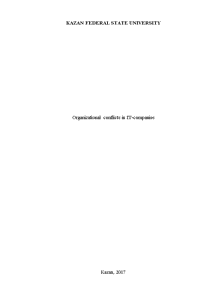Organizational conflicts in IT-companies 3
References 7
The nature of the conflict is closely related to the characteristics of human behavior. Carrying out a purposeful activity in a certain sphere, everyone strives to solve their own problems, including satisfying vital needs.
At the same time, the subjective perception of the world around us and of the work itself leads to contradictions arising in the process of people's joint activity. In the process of understanding the difference of the goals and ways to achieve them, different members of the organization have contradictions that can lead to conflicts...
Organizational conflicts in IT-companies (Организационные конфликты в российских IT-компаниях) №1506678
Артикул: 1506678
- Тип работы: Эссе
- Предмет: Английский язык
- Уникальность: 60% (Антиплагиат.ВУЗ)
- Разместил(-а): 103 Егор в 2017 году
- Количество страниц: 8
- Формат файла: docx
1 490p.
1. Anderson, Donald L. (2016) Organization Development: The Process of Leading Organizational Change. – New York : Sage Publications Inc.
2. Eisenhardt, K. M. & Bhatia, M. M. (2002). Organizational complexity and computation. In. J. A. C. Baum (Ed.), The Blackwell companion to organizations (pp. 442–466). Oxford: Blackwell.
3. Hoffman, R. (2014). Exploring the link between uncertainty and organizing processes: complexity science insights for communication scholars. Communication Theory, 18, 426–447.
4. Katz, D. & Kahn, R. L. (1966). The social psychology of organizations. New York, NY: Wiley.
5. Khalil, E. L. (2014). Social theory and naturalism. In E. L. Khalil & K. E. Boulding (Eds.). Evolution, complexity and order (pp. 1–39). London, UK: Routledge.
6. Lissack, M. R. (2013). Knowledge management redux: Reframing a consulting fad into a practical tool. Emergence, 2(3), 78–89.
7. Lissack, M. R. & Letiche, H. (2012). Complexity, emergence, resilience, and coherence: gaining perspective on organizations, and their study. Emergence, 4(3), 72–94.
8. Mayo, G. E. (2015) The Social Problems of an Industrial Civilization / G. E. Mayo. – New York: Routledge.
9. Thompson, K. (2015) Organization and Management: Selected Papers / K. Thompson, C. I. Barnard. – New York : Routledge.
10. MacGregor, D. The Human Side of Enterprise / D. MacGregor. - http://msbmonline.org.uk /campus/onlinelibrary/ books/humansideofenterprise.pdf
11. Schumpeter, J. A. Creative Destruction / J. A. Schumpeter. – http://transcriptions. english.ucsb.edu/ archive /courses/liu/english25/materials/schumpeter.html.
2. Eisenhardt, K. M. & Bhatia, M. M. (2002). Organizational complexity and computation. In. J. A. C. Baum (Ed.), The Blackwell companion to organizations (pp. 442–466). Oxford: Blackwell.
3. Hoffman, R. (2014). Exploring the link between uncertainty and organizing processes: complexity science insights for communication scholars. Communication Theory, 18, 426–447.
4. Katz, D. & Kahn, R. L. (1966). The social psychology of organizations. New York, NY: Wiley.
5. Khalil, E. L. (2014). Social theory and naturalism. In E. L. Khalil & K. E. Boulding (Eds.). Evolution, complexity and order (pp. 1–39). London, UK: Routledge.
6. Lissack, M. R. (2013). Knowledge management redux: Reframing a consulting fad into a practical tool. Emergence, 2(3), 78–89.
7. Lissack, M. R. & Letiche, H. (2012). Complexity, emergence, resilience, and coherence: gaining perspective on organizations, and their study. Emergence, 4(3), 72–94.
8. Mayo, G. E. (2015) The Social Problems of an Industrial Civilization / G. E. Mayo. – New York: Routledge.
9. Thompson, K. (2015) Organization and Management: Selected Papers / K. Thompson, C. I. Barnard. – New York : Routledge.
10. MacGregor, D. The Human Side of Enterprise / D. MacGregor. - http://msbmonline.org.uk /campus/onlinelibrary/ books/humansideofenterprise.pdf
11. Schumpeter, J. A. Creative Destruction / J. A. Schumpeter. – http://transcriptions. english.ucsb.edu/ archive /courses/liu/english25/materials/schumpeter.html.
Материалы, размещаемые в каталоге, с согласия автора, могут использоваться только в качестве дополнительного инструмента для решения имеющихся у вас задач,
сбора информации и источников, содержащих стороннее мнение по вопросу, его оценку, но не являются готовым решением.
Пользователь вправе по собственному усмотрению перерабатывать материалы, создавать производные произведения,
соглашаться или не соглашаться с выводами, предложенными автором, с его позицией.
| Тема: | Organizational conflicts in IT-companies (Организационные конфликты в российских IT-компаниях) |
| Артикул: | 1506678 |
| Дата написания: | 20.12.2017 |
| Тип работы: | Эссе |
| Предмет: | Английский язык |
| Оригинальность: | Антиплагиат.ВУЗ — 60% |
| Количество страниц: | 8 |
Скрин проверки АП.ВУЗ приложен на последней странице.
Organizational conflicts in IT-companies (Организационные конфликты в российских IT-компаниях), Эссе по предмету Английский язык - список файлов, которые будут доступны после покупки:
Пролистайте готовую работу "Organizational conflicts in IT-companies (Организационные конфликты в российских IT-компаниях)" и убедитесь в ее качестве перед тем как купить:
После покупки артикул автоматически будет удален с сайта до 21.02.2025






Посмотреть остальные страницы ▼
Уникальность эссе — 60% (оригинальный текст + цитирования, без учета списка литературы и приложений), приведена по системе Антиплагиат.ВУЗ на момент её написания и могла со временем снизиться. Мы понимаем, что это важно для вас, поэтому сразу после оплаты вы сможете бесплатно поднять её. При этом текст и форматирование в работе останутся прежними.
Качество готовой работы "Organizational conflicts in IT-companies (Организационные конфликты в российских IT-компаниях)", проверено и соответствует описанию. В случае обоснованных претензий мы гарантируем возврат денег в течение 24 часов.
Утром сдавать, а работа еще не написана?

Через 30 секунд после оплаты вы скачаете эту работу!
Сегодня уже купили 70 работ. Успей и ты забрать свою пока это не сделал кто-то другой!
ПРЕДЫДУЩАЯ РАБОТА
Нетарифное регулирование сельскохозяйственного рынка стран ЕС: опыт и возможность его использования в РФ
СЛЕДУЮЩАЯ РАБОТА
Кеннет Боулдинг

